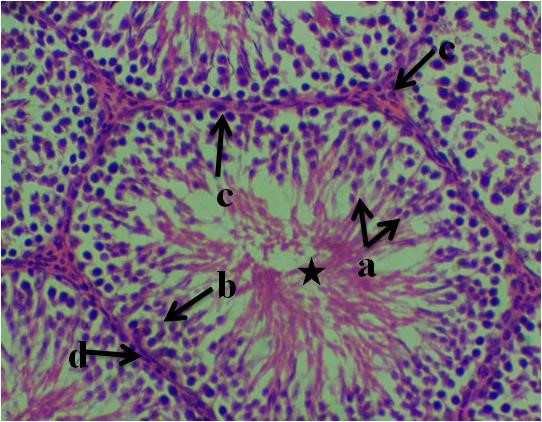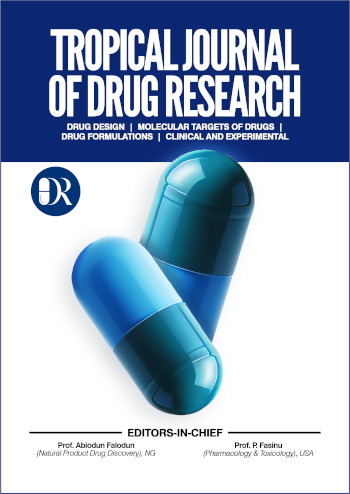Histological Investigation of the Protective Effect of Lonchocarpus griffonianus (Baill.) Dunn (Fabaceae) Stem Bark Extract on Aluminium Chloride-induced Testicular Toxicity in Albino Mice
DOI:
https://doi.org/10.26538/tjdr/v2i9.2Keywords:
Lonchocarpus griffonianus, testicular toxicity, Aluminium chloride, Albino mice, methanol extractAbstract
Purpose: Complications associated with male infertility, such as relationship issues and stress brought on by not being able to conceive, as well as the cost of fertility treatments, have led to a desire for safe, inexpensive, and easily accessible fertility-enhancing herbal remedies. Lonchocarpus griffonianus (Fabaceae) is utilized by the natives of Akwa Ibom State, Nigeria, to treat pharyngopulmonary disorders, stomachaches, infertility, amenorrhea, and inflammatory disorders. This study aims to validate the use of L. griffonianus in the management of infertility in ethnomedicine.
Methods: L. griffonianus stem bark was collected, identified, dried, pulverised, and then extracted with absolute methanol. Aluminium chloride (4.3mg/kg) was given intraperitoneally to the animals to induce reproductive toxicity for 28 days. The extract was administered at graded doses of 100, 200, and 400 mg/kg orally, along with Aluminium chloride, for 28 days. On day 29, the animals were sacrificed under anaesthesia. The animal’s testes were harvested for histological analysis.
Results: The demonstrated significant restorative effects on aluminium chloride–induced testicular toxicity in male mice. The standard control group exhibited normal testicular histoarchitecture with intact germ cells and spermatozoa. In contrast, the disease control group showed vacuolated connective tissue, atrophied spermatids, and scanty spermatozoa. Treatment with the extract (100–400 mg/kg) markedly improved spermatogenesis.
Conclusion: L. griffonianus stem bark extract attenuated AlCl3-induced testicular toxicity, indicating its potential as a lead for developing herbal therapies against male infertility.
Downloads
References
1. Agarwal A, Baskaran S, Parekh N, Cho CL, Henkel R, Vij S, Arafa M, Kumar M, Shah R. Male infertility. Lancet. 2021; 397(10271):319–333.
2. Babakhanzadeh E, Nazari M, Ghasemifar S, Khodadadian A. Some of the factors involved in male infertility: a prospective review. Int J Gen Med. 2020:29–41.
3. Farhadi-Azar M, Naz MSG, Ghahremani M, Mousavi M, Azizi F, Tehrani FR. Self-reported Male Infertility and Metabolic Disturbance: A Cross-Sectional Study. Int. J. Endocrinol. Metab. 2023; 21(2) e134895
4. Presunto M, Mariana M, Lorigo M, Cairrao E. The Effects of Bisphenol A on Human Male Infertility: A Review of Current Epidemiological Studies. Int. J. Mol. Sci. 2023; 24 (15):12417.
5. Mansour FR, Nabiuni M, Amini E. Ovarian Toxicity Induced by Aluminum Chloride: Alteration of Cyp19a1, Pcna, Puma, and Map1lc3b genes Expression. Toxicol. 2022; 466:153084.
6. Boudou F, Bendahmane-Salmi M, Benabderrahmane M, Benalia A, Beghdadli B. The impact of aluminum chloride sub-acute exposure on the reproductive system of male rats. J. Exp. Clin. Cancer Res. 2020;8(4):2502-0524
7. Abarikwu SO, Onuah CL, Singh SK. Plants in the management of male infertility. Andrologia. 2020 ;52 (3) :e13509.
8. Ambe D, Ayinde B. Lonchocarpus griffonianus (BAILL) DUNN (Fabaceae) Attenuates Growth Proliferation: An Index of Usage in Cancer Management. Nig. J. Appl. Sci. 2023;41(1):16–22.
9. Ambe DA, Nyong EE, Ukpong AW. Biosafety Evaluation of Methanol Extract of Stem Bark of Lonchocarpus griffonianus (Baill.) Dunn (Fabaceae) in Sprague-Dawley Rats. Int J Biochem Res Rev. 2023;32(10):20–6.
10. Arhoghro E, Sule O. Ethanolic root extracts of Rauwolfia vomitoria ameliorates reproductive toxicity and oxidative stress induced by Aluminum chloride in rats. World J. Pharm. Pharm. Sci. 2017; 6(5):1770–1781.
11. Okonofua FE, Ntoimo LFC, Omonkhua A, Ayodeji O, Olafusi C, Unuabonah E, Ohenhen V. Causes and risk factors for male infertility: a scoping review of published studies. Int. J. Gen. Med. 2022:5985–5997.
12. Kumar P, Singh P. Withania somnifera Ameliorates Aluminium Chloride-induced Testicular Toxicity and Impaired Fertility in Mus musculus. Indian J. Pharm. Sc. 2020;82(3):398-408
13. Khattab FKI, Khattab I. Histological and ultrastructural studies on the testis of rat after treatment with Aluminium chloride. Aust. J. Basic Appl. Sci. 2007;1(1):63–72.
14. R. Dias T, Martin-Hidalgo D, M. Silva B, F. Oliveira P, G. Alves M. Endogenous and exogenous antioxidants as a tool to ameliorate male infertility induced by reactive oxygen species. Antioxid Redox Signal. 2020;33(11):767-785.
15. Jambor T, Arvay J, Ivanisova E, Tvrda E, Kovacik A, Greifova H, Lukac N. Investigation of the properties and effects of Salvia officinalis L. on the viability, steroidogenesis and reactive oxygen species (ROS) Production in TM3 Leydig cells in vitro. Physiol. Res. 2020;69(4):661-673 doi: 10.33549/physiolres.934457
16. Kumar A, Kumar R, Rahman MS, Iqubal MA, Anand G, Niraj PK, Ali M. Phytoremedial effect of Withania somnifera against arsenic-induced testicular toxicity in Charles Foster rats. Avicenna J. Phytomed. 2015;5(4):355-364.
17. Abd HH, Ahmed HA, Mutar TF. Moringa oleifera leaves extract modulates toxicity, sperms alterations, oxidative stress, and testicular damage induced by tramadol in male rats. Toxicol. Res. 2020;9(2):101-106.
18. Ara C, Asmatullah, Butt N, Ali S, Batool F, Shakir HA, Arshad A. Abnormal steroidogenesis, oxidative stress, and reprotoxicity following prepubertal exposure to butylparaben in mice and protective effect of Curcuma longa. Environ. Sci. Pollut. Res. 2021;28(5):6111-6121.

Downloads
Published
Issue
Section
License

This work is licensed under a Creative Commons Attribution-NonCommercial-ShareAlike 4.0 International License.




